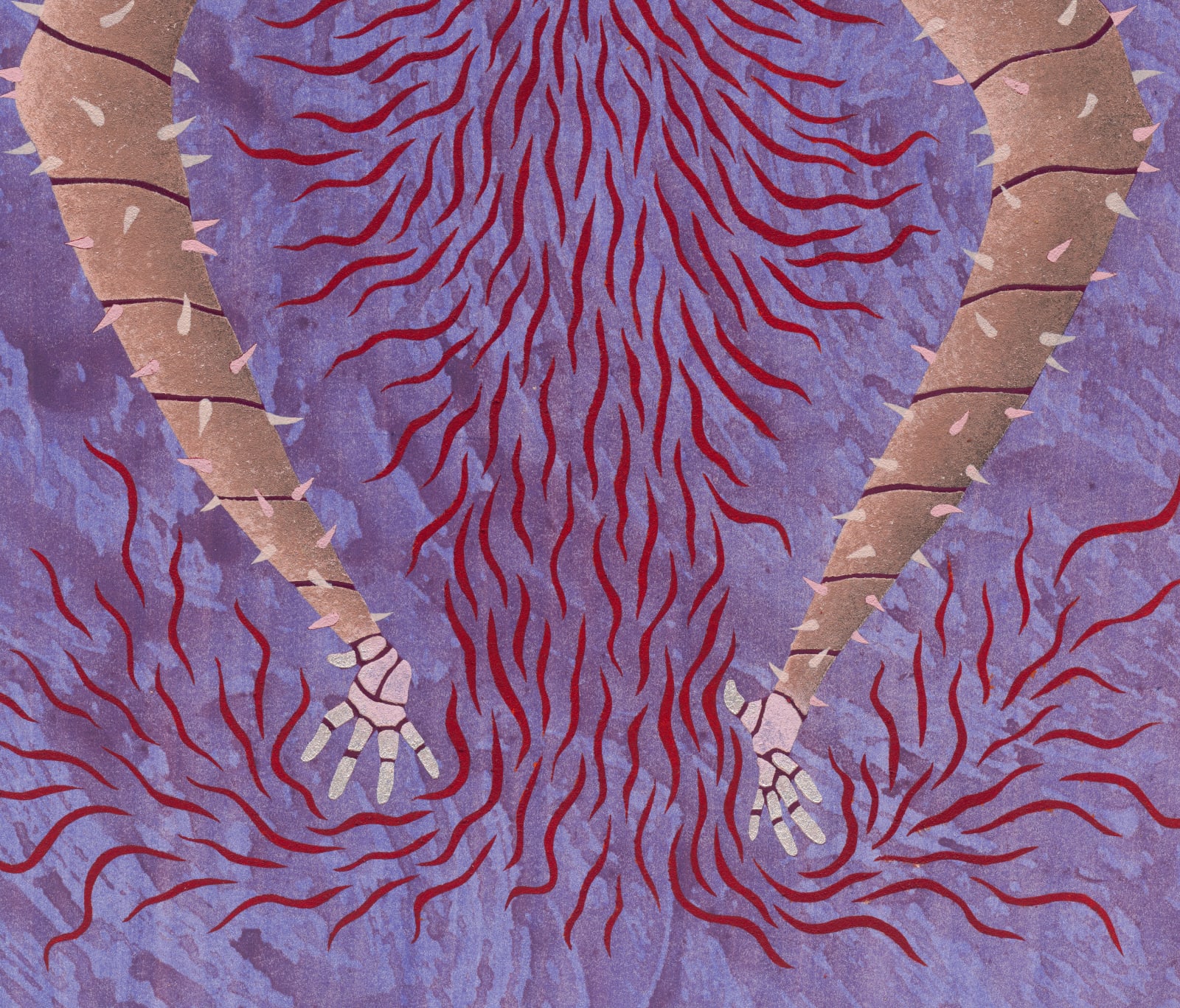Felipe Baeza
Further images
Felipe Baeza’s Beyond the Vessel (2024) is an intricate and deeply evocative work that expands his ongoing exploration of transformation, memory, and the fluid boundaries of identity. Executed through a complex layering of techniques—including watercolor monoprint, photolitho, screenprint, pochoir, and collage—the piece pulsates with a sense of metamorphosis. Against a swirling, texturally rich purple ground, a hybrid figure emerges, its elongated, segmented arms stretching outward while red tendrils radiate from its mouth and torso like living filaments of energy. These elements suggest a being in flux, a liminal presence neither fully human nor entirely other, caught in a continuous state of becoming. The body appears sutured together, reinforcing themes of rupture and repair, as if the figure itself is an archive of transformation—bearing both the scars and the resilience of an existence shaped by displacement and reinvention.
Baeza’s approach to paper as an active, transformative surface is fundamental to the emotional and conceptual weight of this piece. His use of monoprinting and pigment absorption techniques allows for an organic, almost subconscious interplay of color and texture, while the meticulous application of pochoir and collage introduces elements of precision and control. This tension between fluidity and structure mirrors the psychological landscapes his work evokes, where personal and collective histories are layered, scraped away, and reassembled. The hybrid techniques employed here heighten the sense of material vulnerability—paper itself becomes a fragile yet tenacious vessel, holding within it the residues of memory, myth, and bodily experience.
Within the broader scope of Baeza’s oeuvre, this work continues his engagement with mythology and psychoanalysis as tools for reimagining identity. The spectral, fugitive quality of his figures draws upon pre-Columbian, Catholic, and folk traditions, but these references are unsettled, remixed, and transformed. Here, the figure appears both human and vegetal, its limbs resembling segmented exoskeletons, while the flowing red filaments suggest breath, spirit, or even psychic emanations. These elements recall ancient mythologies of shape-shifting beings and visionary states, yet they are rendered with an immediacy that speaks to contemporary conditions of migration, impermanence, and self-reconstruction. The work resists fixity, offering instead a vision of identity as something porous, unstable, and perpetually in motion.
Delicate in scale yet profound in psychological depth, Beyond the Vessel reaffirms Baeza’s ability to merge technique with concept, craft with poetics. His deliberate choices—of texture, layering, and incision—echo the very processes of remembrance and reinvention that define his subject matter. This work is not simply an image; it is an invocation, a manifestation of unseen forces that shape the self and its histories. In Baeza’s hands, paper is no longer a passive support—it is a living, breathing entity, absorbing, preserving, and revealing the traces of transformation. Through Beyond the Vessel, Baeza offers a vision of the self as fragmented yet whole, scarred yet resilient—a body in flux, unbound by fixed narratives, existing instead in the liminal space between erasure and emergence.
NOTES
This work was graciously donated by the artist to support The Immigrant Artist Biennial. All proceeds from the sale will benefit TIAB.
The Immigrant Artist Biennial is the only large-scale biennial to focus on immigrant artists. Through its 2020 and 2023 editions, TIAB has presented work by over 150 artists through various formats, facilitating a platform of support for projects by often overlooked and silenced voices. Established by Ukrainian-born artist Katya Grokhovsky, TIAB is fiscally sponsored by New York Foundation for the Arts and funded through its host partners, grants, sponsorships, donations, and Patron Circle.
Provenance
The artistThe Immigrant Artist Biennial, gift from the above






